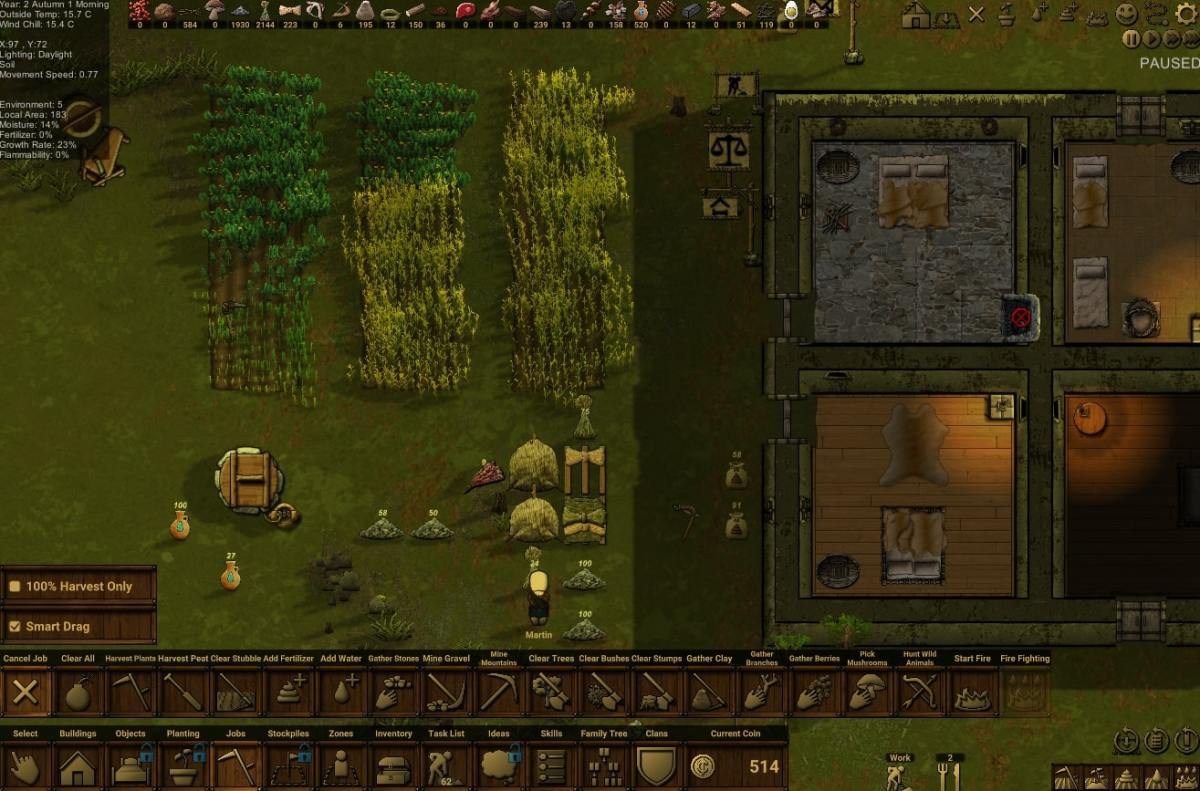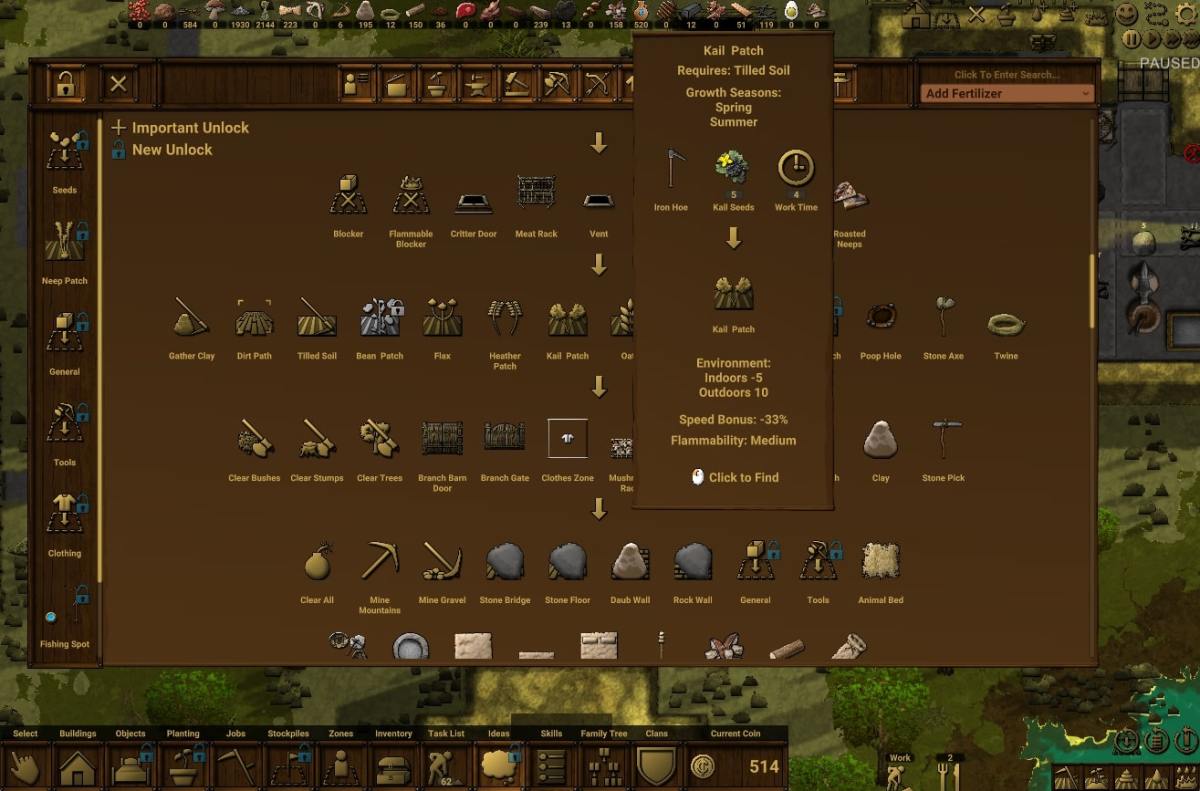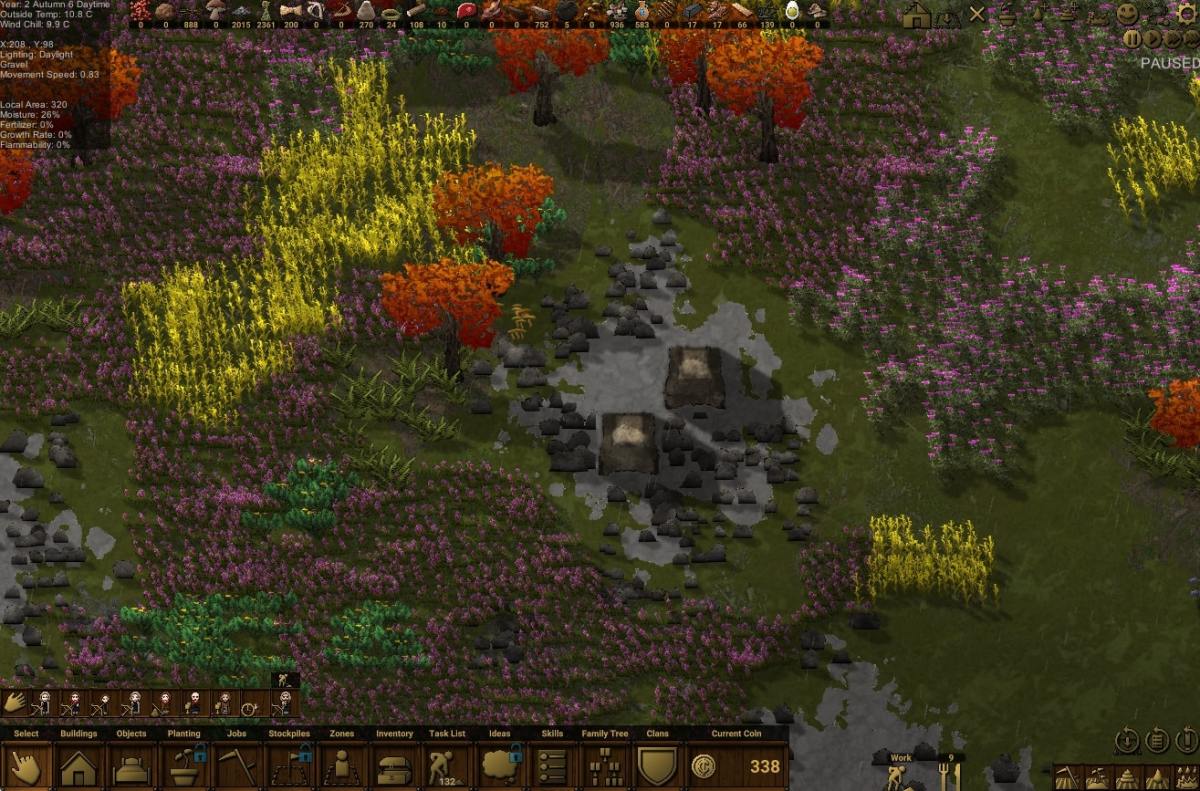Has Scottish, colony-sim, Clanfolk, really been in early access for nearly two years? It’s the game that made me obsessed with grass – you have to consider grass diversity, preserve wild grass; farm cultivable varieties; manage oats, flax, hay, straw; harvest grass seeds; and then safely store everything grass-related through winter. Update 14 piqued my curiosity, so I came back after a long break and there’s so much more grass.
I mean, thistles, heather, bluebells… Maybe they’re not actually grass. Onions, neeps and beans are more a collection of ‘bits and bobs to put in your pottage stew’. But all of these weed-like things have entangled themselves into the complex ‘ideas’ system since last I played. And I love every one of them.
I did initially tell GamesHub’s editor that I wouldn’t talk about grass. This preview was supposed to be about the negotiation system, which has also neatly arrived inside the overall experience. But, we ended up agreeing that grass was extremely interesting, especially after developer, Andrew Hume, provided us with an extensive, grass-related interview.
Is it always greener?
Clanfolk’s grass was ‘love at first sight’ for me, and Hume explained why. I did not completely understand his description of its implementation, but I can appreciate that creating a beautiful game doesn’t happen by accident; it is incredibly detailed, under the hood.
Hume says, “Each tile of grass is subdivided into 36 sub-tiles, each with a small grass sprite that will grow, move with the wind, show moisture content, be displaced as someone walks past, and (if located on a common path) be trampled. With offsets to provide variable growth, position and colour, grass can feel organic and a full map of grass would have 1.4 million grass sub-tiles.” What?!
“As grass grows, I draw more and more of the original sprite – made of 5 carefully placed lines – using a control colour. The darker the control colour, the later the grass pixel draws, meaning that it’s only when flax is ripe that the blue flowers will pop open. With young grasses, only a few little points stick out of the ground, then the tile thickens gradually. As soil fertility increases (like near the ‘poop hole’), grass will be greener and taller.”
“Grass will be shorter and yellower in Summer, perking up again in Autumn, until Winter finally sees grass recede to almost nothing,” said Hume. Yes, I had noticed my grass’ colours shifting evocatively, by season.

In terms of how grass is distributed, Hume says, “When the map generates, there is a randomised fertility texture that covers it, then I drop seeds from orbit. Seeds in high fertility areas are more likely to survive, then a growth algorithm creates fields. Some areas will be good for grass, others for thistle or heather, giving fields a more natural appearance.”
After documenting this, I spent a good 20 minutes staring at one screenshot of Clanfolk’s grass, to try to disprove … anything, by finding some repeating, visual pattern, but I could not.
Grass is not only intricate in a pretty way, of course, it also drives several core aspects of play. When asked about the most interesting thing he had learned about grass, while making Clanfolk, Hume said, “Definitely how linen is made.”
When I played Clanfolk two years ago, I became intensely curious about ‘retting’, having never previously heard of it. I even found stories about people retting traditionally, in modern times, in baby pools and the snow. Hume describes the linen making process as follows,
“1: Rip the flax out of the ground to get the longest fibres possible.
2: Take it to the nearest water source and dunk it for weeks until it rots (retting).
3: Beat the rotten flax stems in three exciting ways – breaking, scutching, hackling – to extract the fibres.
4: Spin the fibres into thread hanks; a slow Winter process.
5: Use the loom to turn the threads into cloth.
6: Tailor the cloth into your one shirt for the next year.”
It does take (at least) a year to make a linen shirt in Clanfolk. The first time I did so, I felt like I’d won the game. This was previously one of the most complex tasks to achieve, alongside baking bread, but complexity has also intensified, overall. I have not yet achieved the creation of a fish stew, but I will continue to try.

Clanfolk is full of ideas
The game involves an ideas system, which is like a tech tree that you unlock via engagement, rather than research. So, after you collect 50 berries and have also unlocked ‘straw’, your clanfolk have the ‘idea’ to build a serving basket. So, how does Hume integrate new elements, like kail (from seed to stew), into the ‘ideas’ system?
He says, “The ideas system is self managing. There is no way I could keep track of all the relationships that unlock each new idea. When I create a new item, I define a recipe to build it, and the requirements to unlock it. The unlocking tree is then generated, so I run Clanfolk to see where the new item has ended up in the ideas tree, and then add more criteria if it seems too soon, too easy, or illogical, as a discovery.”
It’s becoming clear that Hume is developing a game that scales convincingly with scope, thanks to robust initial decision making for the random generation of content, and systems that are designed to have new things plugged into them. This seems really clever.
I did ask Hume why there were so many buildings (including new ones) made from straw, and he provided several plausible, historical reasons, including the one I had always suspected: “Straw ALSO burns really well.” Completing your precious linen shirt, then watching helplessly as the barn goes up in flames, is the kind of medium-sized drama that makes Clanfolk so endearing.
If you’re considering revisiting Clanfolk to experience ‘negotiation’ in Update 14, it is a genuinely new, additional system, however, there is only one (somewhat more explicitly dramatic) ‘event’ currently implemented, and it begins after Day 30.
In my game, just as the first year’s snows began to clear – and occasional, randomised, grass sprites poked through the soil – a young woman shuffled into my colony, needing a safe place to have her baby. My folk whipped up a straw sleeping mat, just outside of the spark radius of their only stone fireplace, and generously escorted her to racks of dried mushrooms.
I won’t spoil what happens next, but there are branching variations by which this can play out, depending on your decisions and the clan’s capacity to provide aid. I can immediately appreciate how many more such stories might take root within this thoughtfully crafted, new infrastructure. Hume has planted another perfect seed.
Read: 6 calming games to play if you’re stressed
I was recently diagnosed with two (very annoying) new allergies, both to grass, fescue and rye. And so, I have a new immunotherapy regime and a medicine cabinet full of Dymista. What happened to Scottish people in the 1300s with grass allergies? Surely nothing good.
When I asked Hume, he replied, “I don’t know, historically, but I do know that Clanfolk will now (have grass allergies). That’s an excellent quirk to add. Thanks!”
I look forward to the emergent drama stemming from Clanfolk’s new negotiation system. Given how conclusively grass underscores this game, an expectant mother with allergies could be a real challenge.





